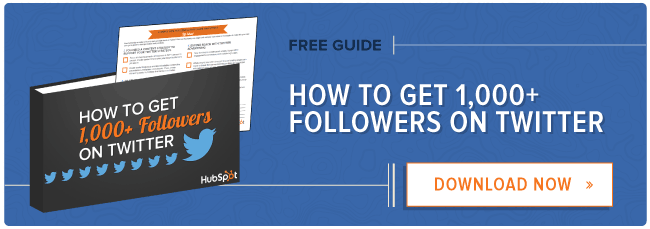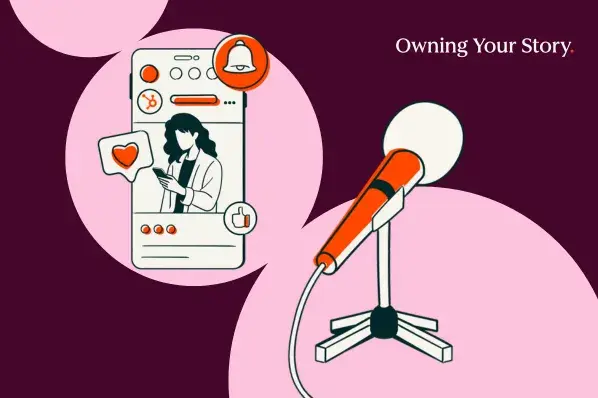For most businesses, generating leads is the ultimate benefit of creating and maintaining a social media presence.
But first things first: In order to make social media an effective lead generation machine, you first need to generate a following. This means fans and followers on Facebook, Twitter, LinkedIn, Instagram, and your other social media accounts.
The more fans and followers you have for your social media presence, the better reach you'll have. And better reach means the potential to generate more leads. So at the very core of social media for lead generation, you must take steps to increase your reach.
Download our free guide here to learn how to get more followers on Twitter.
Sure, you could buy your first few hundred followers to get the ball rolling. But the key to a high quality social following is to actually earn your fans and followers.
Why? Because purchased followers are either fake or low-quality profiles, so they really serve no purpose except to artificially inflate your follower count. You don't get any meaningful interaction from them. On the other hand, followers you earn are the people who will Like and share your photos, click on the links you share, learn more about you and your business, and maybe even do business with you in the future.
To help you get started, here are eight helpful tips for expanding your social media reach.
8 Tips for Getting More Social Media Followers, Fans, and Likes
1) Prioritize the social networks where your fans are likely to be.
"Which social media network should I focus on?" This is one of the most commonly asked questions marketers have. We recommend that you create and maintain a presence on the top social networks (Facebook, Twitter, LinkedIn, Instagram, and Pinterest), but focus your efforts on the social media networks where your target buyers are spending time.
Create profiles for all the top social networks.
Have you ever found yourself wanting to tweet to or about a company, only to find they don't have a Twitter account? I have. Not only is it frustrating, but it also kind of seems amateur and unprofessional. It also creates distance between your brand and your customers and potential customers.
I like the way JetBlue's manager of customer commitment Laurie Meacham put it: At JetBlue, they're all about the people -- meaning their customers and potential customers -- and being on social media is just a natural extension of that.
No matter what size your company is, which industry you work in, or which target market you're going after, people are going to talk -- or going to want to talk -- about you on every social network. So it's important that you at least give folks the option to get in touch with you on their social network of choice, and maintain some sort of presence there.
Here are a few resources for getting you started on the five major social networks:
- An Introduction to Twitter for Business
- An Introduction to Facebook for Business
- An Introduction to LinkedIn for Business
- An Introduction to Instagram for Business
- An Introduction to Pinterest for Business
Focus on the networks where your target buyers spend time.
It takes a lot of time and resources to keep up multiple social media accounts, so you'll want to make sure you're prioritizing the social networks that matter. That means taking the time to research your buyer personas so you can find out where they hang out on social media. (Download our free buyer persona templates here.) This will help you use social media to generate real customers, and delight existing ones.
Other ways to find out where your target audience hangs out on social is to:
- Ask your customers.
- Run a survey to an anonymous audience.
- Use share data.
- See where your competitors' content is getting shared.
- Do keyword research.
- Check if your industry is active on the network.
Learn about those tips in more detail here.
(HubSpot customers: You can connect your Twitter, Facebook, LinkedIn, YouTube, Pinterest, Google+, Xing, and blogging platform RSS feeds with your HubSpot account. Learn how to integrate these social profiles with HubSpot here.)
What about where to focus your social media advertising efforts? Read this blog post to learn the pros and cons of advertising on LinkedIn, Twitter, Google+, and Facebook.
2) Optimize your social profiles.
Whether you already have profiles for your business or you have yet to create them, it's important to think about how you can optimize your social profiles.
This includes choosing an easily identifiable username, uploading a recognizable photo (like your company logo), including clear and concise descriptions of your business, and leading people back to your website with a trackable link. There are some nuances depending on the social network, though -- like cover photos
Here are a few resources for how to optimize your profiles on different social networks.
Facebook:
- 19 Essential Tips for an Engaging Facebook Business Page
- Facebook Cover Photo Do's & Don'ts (+ Pre-Sized Templates)
Twitter:
LinkedIn:
- A Visual Guide to Creating the Perfect LinkedIn Company Page
- How to Craft the Perfect LinkedIn Profile: A Comprehensive Guide [Infographic]
Instagram:
Now that social media updates are included in search results, you should also do your best to optimize the content you're actually publishing on those networks, like tweets, Facebook posts, and LinkedIn company status updates. For example, including keywords appropriate for your business could help you get found in search. (Just make sure you're incorporating them in a way that sounds natural.)
3) Promote your social presence everywhere.
And by everywhere, we mean everywhere: On various pages of your website, on your blog, on signage in your storefront (if you're a local business), in print advertising, on your business cards, in your email marketing messages.
Many social media sites now have official "Follow" buttons you can include on your website and blog. That way, people can start following you with a single click -- without ever having to leave your website or blog. You can create them easily by following the instructions in this guide for creating social media buttons. (Note for HubSpot customers: Many of these buttons come out of the box with HubSpot's Social Media software.)
If you want to create "Follow" buttons for a social network that doesn't offer premade ones, or if you'd simply rather create your own custom buttons, you can by following these instructions from the folks at iFabbo.
Cross promotion across all your social media accounts is also a great way to let your social followers know where else on social media they can find you. That way, you can get your Twitter followers to become your Facebook fans; to get your Facebook fans to become your Instagram followers; and so on.
Depending on your goals, this could mean posting links to your other social accounts in a normal post, paying for sponsored updates pointing people to other social networks, or adding a link to another social site in the bio or description section of a different one.
For example, the folks at Cava Mezze Grill are promoting their Instagram account on Facebook by giving their Instagram feed its own tab on their Facebook Page, along with a "View on Instagram" button linking to their page. Check it out:

If you have a Snapchat account, Snapcodes are perfect for cross channel promotion on your other social media profiles. Basically, every Snapchat user has a unique Snapcode, which is an image that looks like the Snapchat logo but with a unique pattern of dots. To follow you on Snapchat, all users will have to do to is open the Snapchat app, take a photo of your Snapcode, and tap their screen. Here's an example from HubSpot's Instagram account:
4) Add social sharing buttons to all your content.
Just as you should be promoting your social presence in as many places as possible, you should also be enabling your site visitors and email subscribers to share your content with their personal networks as easily as possible.
By evangelizing your audience to share your content, you'll have better potential to reach a broader audience that extends beyond your direct network of fans and followers. (And if those people like the content that their friends are sharing with them, they may be inclined to become direct followers of you, too.)
Add social sharing buttons (e.g., "Share on Facebook," "Tweet This," etc.) to all of your content -- on individual blog articles, in email messages, on landing pages for ebook and webinar downloads, within the pages of your ebooks, and so on. Here's an example:
And another one:
(See what I did there?)
You can create these "Share" buttons easily by following the instructions in this guide for creating social media buttons. (Note for HubSpot customers: Many of these buttons come out of the box with HubSpot's Social Media software.)
5) Share useful, valuable content.
It's not just enough to promote your presence. You need to make sure your presence is something that's worth following in the first place.
Make sure your tweets, Facebook posts, and LinkedIn updates consist of valuable, useful, and engaging content. Avoid product-focused content, and instead, aim for social updates that contain educational content that has the potential to attract more fans and followers. Here are four tips to help you out:
Tip #1: Master the 80/20 rule.
When in doubt, use the 80/20 rule: 80% of the content you post to social media should be helpful and valuable to your audience, and 20% can be self-promotional. Once you gain a following by tweeting valuable content, you'll have the chance to promote yourself when you need to 20% of the time. You might not need to promote anything now -- and that's okay. Later, you'll be glad you've built up a loyal following that may pay attention when you need to drive traffic to your website (or elsewhere).
Tip #2: Post a variety of content.
It's super important to post a variety of content to keep your social media channels fresh, interesting, and engaging. Some of the world’s most famous companies use social media variety to keep their social audiences constantly interested.
For example, Amazon.com regularly supplements its "core product posts" with competitions, video, multi-media, polls, and promotions -- all of which have contributed to their current Facebook Like figure of 26 million+ and 2.3 million+ followers on Twitter.
Tip #3: Post compelling visual content. A lot of it.
Visual content is probably the most powerful tool your brand can use to engage your fans on social media because it allows you to express ideas quickly and effectively. It's a valuable tactic to set your brand apart from the vast amount of written content published online every day. Plus, your Fans and followers are 44% more likely to engage with content on social media that contains pictures, so be sure you focus a chunk of your effort creating visual content like designs and photographs for these posts.
Read this blog post for helpful tips on making your visual content on social media more compelling. It's chock full of helpful information on how to optimize your image posts for each social network, how often you should be posting visual content to each social network, how to create visual posts for hashtag campaigns, and so on.
Tip #4: Delight your followers.
Last but certainly not least, use social media not just to inform your followers, but to delight them as well. Delightful posts are often the most memorable and shareable, and they'll help you build a loyal following much more than those sometimes-necessary boring posts will.
For example, the folks at Amazon have a lot of stuff they could be posting about on Facebook. And yet, they consistently find space for fun posts like this one:
"Alexa, order dog treats!" #PrimePet
Posted by Amazon.com on Saturday, March 19, 2016
Here's another great one from Innocent Drinks, which has absolutely nothing to do with their brand besides embodying their silly, best-friend-like brand voice:
There's a programme called 'Panda Babies' on ITV right now. PANDA. BABIES.
— innocent drinks (@innocent) January 31, 2016
Check out our list of funny social media posts from famous brands for more ideas on delightful content.
6) Interact with followers and anyone who mentions you.
Most social networks are all about making connections and having conversations. Just as you should be regularly sharing educational, insightful content, you should also be monitoring your presence and interacting with your fans and followers. This'll help you build a loyal, engaging following.
Ask questions, be engaging, and participate in discussions to create a presence worth following. Be sure to monitor mentions of your username, company name, and any unique hashtags every single day. (You can read about how we do social monitoring at HubSpot here to learn how our social media team finds mentions of HubSpot on social media so they can respond and engage with those people.)
Also, take the time to reply when people @-mention you on Twitter or Instagram, or otherwise engage with your brand name. Thank them if they say something nice, answer their questions if they have them, and even respond to the negative comments.
The social media team at JetBlue is a brilliant example of engagement on social media -- particularly Twitter, where they found a lot of their customers talking about them.
But they receive a whole lot of tweets -- between 2,500-2,600 Twitter mentions every day. Woo boy ... that's a lot of mentions. The team at JetBlue handles that volume by prioritizing which tweets to respond to based on where they feel they can contribute value.
"We want our employees to engage smartly, and for the conversations to be organic and natural,"Meacham told me. "We look for opportunities to add value and connect with our customers, not just respond to every single mention that comes our way."
7) Find, follow, and build relationships with people in your industry.
Social media is a great way to find and follow leaders in your industry, which can include both people and other brands that are creating great content related to your industry (and aren't a direct competitor, obviously).
For example, you may want to find and engage with influencers who have an audience that you're targeting. Relationships like those could pay major dividends in the future in a wide variety of ways. You might also find and follow influential bloggers and brands, and retweet or otherwise share their content on your social accounts. Start following some of your own followers -- and the people they're following, too.
Where can you find these people? Here are a few places to start.
It's fairly easy to find top influencers for a given topic on Twitter. You can find them by searching for a keyword on Twitter and scrolling through "Top" tweets, which are the tweets containing that keyword that have seen the most engagement. If you search for a keyword on Twitter and toggle to the "Accounts" tab, you'll find a list of Twitter accounts.

You'll also notice Twitter gives you suggestions for whom to follow. This list can be found on the right-hand side of your home or personal Twitter feed, and it suggests users based on patterns from your "following" history. They're generated by an algorithm, so you may or may not know the accounts or find them relevant -- but it's worth it to scroll through those suggestions every once in a while.
LinkedIn Groups provide great opportunities to find connections with influencers for your business. You don't need to start a group to get the full benefit of LinkedIn Groups. In fact, you should start out by searching for and joining groups that are relevant to your business, and then connecting with group contributors.
The trick to making connections on LinkedIn is to avoid cold connections. Make sure you contribute to the group before trying to connect with the individual who placed it. Then, create a personalized LinkedIn invitation that references your discussion. (Download our free LinkedIn invitation template here.)
If you want to moderate a LinkedIn group yourself, be sure to read this post written by our social media manager at HubSpot on how she manages LinkedIn groups.
Making brand new connections on Facebook can be a little bit trickier than on Twitter or LinkedIn because it doesn't have the culture of business networking that LinkedIn does, nor does it have the non-reciprocal follow expectations that Twitter does. Plus, reaching out to strangers is less socially acceptable on Facebook than it is on other social networks.
As such, we suggest giving your fans and followers content that's worth sharing, in the hopes that they'll share your content and your Page's exposure will grow that way. When it comes to Facebook, a referral from a friend can be far more effective and targeted than any other outreach you do on your own.
Read this blog post for more detailed tips for how to find and engage with interesting people online.
8) Hire a dedicated social media manager.
There's a whole lot more than goes into optimizing a company's social media strategy than someone can do on as a "side project" -- especially with all the important changes and trends that are cropping up in the social media world all the time. Eventually, you'll need to hire a dedicated social media manager to manage your accounts, keep your profiles current, stay on top of trends, post great content, and do a whole lot of experimenting.
But searching for someone to run your social media efforts can be frustrating. While social engagement metrics can be tied back to a business' bottom line, more often than not, social media marketers aren't moving the metrics CEOs care about. This can make it hard to fight for budget or headcount.
Turns out, there's a number of important skills that a social media manager must possess other than "driving engagement." The best social media managers are content creators, marketing analysts, news junkies, customer service reps, community managers and facilitators, funnel marketing managers, and project managers. You can download a ready-made job description for the social media manager role here.
Building your social media reach will take some time, but if you're committed to the steps above, we guarantee you'll start seeing results.
How else do you recommend increasing your social media reach?
Editor's Note: This post was originally published in October 2011 and has been updated and for freshness, accuracy, and comprehensiveness.

Social Media




-1.png)


-Mar-28-2025-05-16-30-8863-PM.png)



![The State of Social Media in 2024: How You Can Drive Communities, Sales & Virality [Data from 1,500+ Social Media Marketers]](https://53.fs1.hubspotusercontent-na1.net/hubfs/53/state%20of%20social%20media%20in%202023.png)